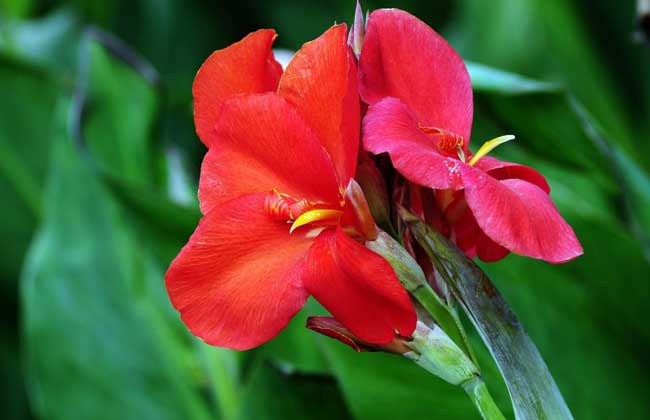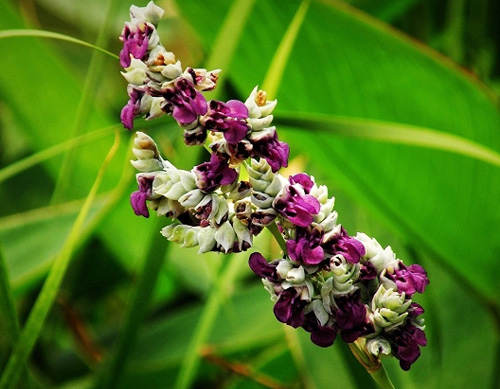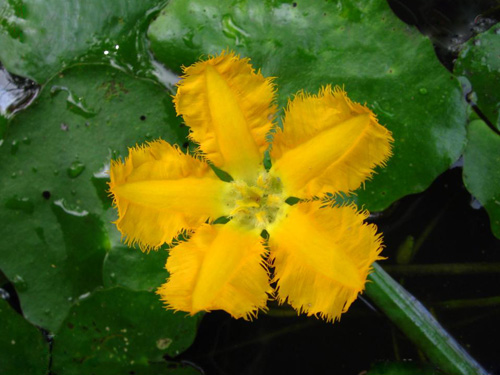Cultivation and management methods of aquatic canna (flower and leaf canna)
Aquatic Canna (Canna variegata)
Filed to: canna glauca
Name: Florida Canna
Family: Canna family Canna genus
Description: Perennial perennial herb, dwarf, plant height 50~80 cm. With root tuber, leaf broad elliptic, alternate, have apparent midrib and pinnate lateral vein, mosaic is worn yellow, milky yellow, green yellow all colors. Terminal racemes, waxy white powder, slightly smaller than the flowers of terrestrial canna, staminodes petaloid, one of which is reversed for the labellum, red, yellow, pink and other colors.
Ecological habits: strong nature, adaptability, like light, afraid of strong wind, suitable for wet and shallow water growth, fertile soil or sandy soil can grow well. The suitable temperature for growth is 15~28 degrees Celsius, and lower than 10 degrees Celsius is not conducive to growth. There is no dormancy period in the origin, annual growth and flowering, winter dormancy in cold northern regions. Rootstocks need to be protected in greenhouse during winter.
Propagation method: planting by dividing tubers. From March to April, tubers are taken out of the soil, sundries are removed, and the tubers are divided with a shovel or a sharp knife. Each tuber has 2 to 3 robust buds as propagation materials. It can also be propagated.
Cultivation and management: In potted plants, the tubers can be directly planted into pots with fertile soil in spring. The growth point is slightly exposed. After planting, they are irrigated with water. They are placed in a shady place for 5~7 days, and then moved to a leeward place for cultivation. Open field planting can choose poolside wetland or shallow water to dig holes and plant in groups, bury tubers in the soil, cover soil 7~10 cm, keep humidity or shallow water after planting.
Flowering: July to October.
The language: noble.
Garden use: wet ground, shallow water, pool cultivation, flower diameter, potted plants.

- Prev

Cultivation and management methods of Zili flower (water bamboo taro)
Then the scientific name of thaliadealbata: water bamboo taro, water lotus banana, Talia. Family and genus: Taro family Talia morphological characteristics: perennial Tingshui herbs, plant height 2m. The whole plant is covered with white powder, leaves ovate-lanceolate, light grayish blue, margin purple, 50 cm long
- Next

The Culture method of Artemisia angustifolia
Nymphoidespeltatum: Gentianaceae: Gentianaceae. Morphological characteristics: perennial floating herbs. Long branches prostrate on the bottom of the water, and short branches grow from the nodes of the long branches. Leaves ovate, base parted into heart-shaped. Umbels born in leaf axils with large and conspicuous flowers
Related
- Fuxing push coffee new agricultural production and marketing class: lack of small-scale processing plants
- Jujube rice field leisure farm deep ploughing Yilan for five years to create a space for organic food and play
- Nongyu Farm-A trial of organic papaya for brave women with advanced technology
- Four points for attention in the prevention and control of diseases and insect pests of edible fungi
- How to add nutrient solution to Edible Fungi
- Is there any good way to control edible fungus mites?
- Open Inoculation Technology of Edible Fungi
- Is there any clever way to use fertilizer for edible fungus in winter?
- What agents are used to kill the pathogens of edible fungi in the mushroom shed?
- Rapid drying of Edible Fungi

